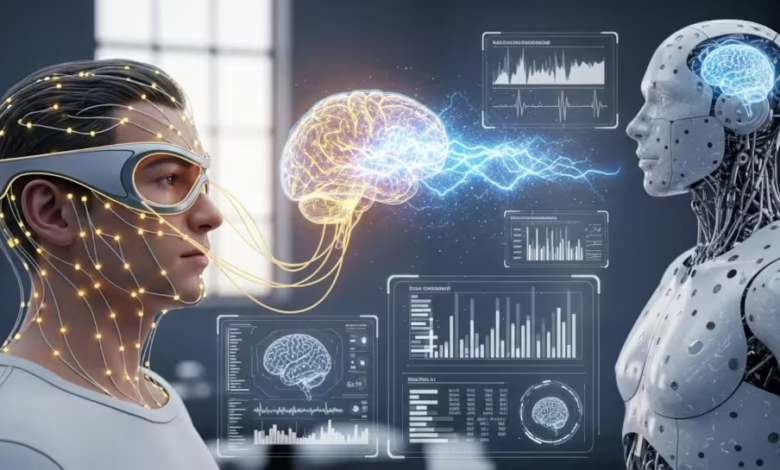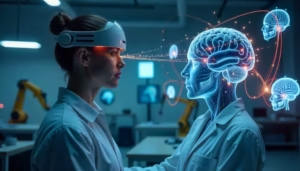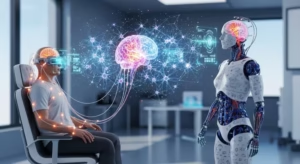AI and Brain-Computer Interfaces: The Merging of Mind and Machine

This blog post explores the fascinating intersection of AI and brain-computer interfaces (BCIs), marking a new frontier in technology. It begins by defining AI and BCIs and how they work synergistically to create powerful tools for communication and control. The article delves into existing BCI technologies, highlighting their diverse applications in fields such as medicine, gaming, and rehabilitation. Furthermore, it examines the potential impact of AI neuro links on the future of neuroscience, offering insights into how these advancements could enhance our understanding of the brain. Finally, the post encourages readers to consider the ethical implications and future possibilities of AI and brain-computer interaction, advocating for proactive engagement in this rapidly evolving domain. By merging mind and machine, AI and brain-computer interfaces hold immense potential to revolutionize human experience and capability.
Understanding AI And Brain-Computer Interfaces: A New Frontier

AI and Brain-Computer Interfaces are revolutionizing how we interact with technology and each other. These cutting-edge neurotechnologies enable direct communication between the human brain and external devices, transforming medical treatments for neurological disorders and enhancing cognitive capabilities. Utilizing advanced algorithms, AI systems can interpret neural signals, allowing for unprecedented control over prosthetics, communication devices, and even virtual environments.
Key Elements to Explore
- Integration of AI algorithms for signal processing
- Neural coding and decoding techniques
- Applications in medical rehabilitation
- Ethical considerations in neurotechnology
- Future capabilities of cognitive enhancement
- Challenges in user interface design
- Collaborative potential between different fields
As the intersection of AI and Brain-Computer Interfaces continues to unfold, it presents both remarkable opportunities and significant challenges. The role of neurotechnology in advancing healthcare solutions cannot be understated, paving the way for new therapies that might restore lost functions or improve mental health. In addition, the implications of merging human cognition with machine intelligence prompt us to explore the ethical boundaries, potential regulations, and societal impacts of these transformative technologies.
Exploring Brain-Machine Interface Technologies And Their Applications

As the integration of artificial intelligence (AI) with brain-machine interfaces continues to evolve, we see groundbreaking advancements in healthcare, communication, and various industries. Brain-machine interfaces (BMIs) allow direct communication between the human brain and external devices, revolutionizing how we interact with technology. In particular, neural implants are being developed to enhance cognitive functions or assist individuals with mobility impairments, marking a remarkable intersection of human capability and robotic assistance.
These technologies harness the power of electrical activity within the brain, translating neural signals into actionable commands that operate computer systems or prosthetic limbs. This seamless interaction fosters potential applications ranging from gaming to advanced medical treatments. As we delve into the significant importance of AI and brain-computer interfaces, it becomes evident that the implications are vast, with endless possibilities for enhancing human potential and quality of life.
| Technology | Applications | Future Prospects |
|---|---|---|
| Neural Lace | Enhanced communication; cognitive boosting | Full brain integration with devices |
| Deep Brain Stimulation | Treatment of Parkinson’s and depression | Personalized treatment plans aided by AI |
| Brain-Computer Interfaces in Gaming | Immersive gaming experiences | Real-time user feedback and adaptation |
| Prosthetic Control via Neural Implants | Restoration of mobility | Intuitive control with minimal effort |
Despite the promising advancements, the implementation of brain-machine interface technologies is fraught with challenges. Issues such as ethical concerns regarding personal privacy, potential misuse of technology, and the physical safety of neural implants must be rigorously examined. Additionally, the durability and long-term viability of these implants remain topics of extensive research and debate, necessitating thorough testing and evaluation before widespread acceptance.
Key Technologies
The technologies that facilitate brain-machine interface development encompass an array of innovative designs and methodologies. Robust algorithms programmed with AI capabilities enable more efficient decoding of neural signals, while advanced materials for neural implants ensure better biocompatibility and functionality. Maintaining seamless integration between the user and technology is critical to success in this field.
Steps to Implement Brain-Machine Interfaces
- Define the purpose and scope of the brain-machine interface.
- Research and choose appropriate neural recording technologies.
- Develop a robust signal processing algorithm powered by AI.
- Create neural implant prototypes with biocompatible materials.
- Conduct iterative testing with subjects to ensure effectiveness and safety.
- Refine and enhance user interfaces based on feedback.
- Launch pilot programs and gather extensive data for further improvement.
Addressing these issues will be crucial for maximizing the potential of AI and brain-computer interfaces while ensuring that societal implications are thoroughly considered. As we venture further into this fascinating frontier, the collaboration of engineers, neuroscientists, ethicists, and policymakers will be necessary to guide the responsible evolution of this technology.
The Impact Of AI Neuro Links On Future Neuroscience

The integration of AI neuro links in neuroscience promises to revolutionize how we understand and interact with the brain. As neurotechnology continues to advance, these connections between artificial intelligence and brain insights are leading to unprecedented opportunities for diagnosing and treating neurological disorders. With AI analyzing large datasets from brain activity, researchers can uncover intricate patterns that were previously undetectable, enabling a deeper understanding of cognitive functions and mental health issues.
Benefits of AI Neuro Links
- Enhanced brain mapping capabilities
- Improved neurofeedback for mental health treatments
- Accelerated drug discovery processes
- Personalized therapeutic approaches in neurology
- Real-time monitoring of neural conditions
- Advanced rehabilitation techniques for brain injuries
- Insights into neurodegenerative diseases
As we delve deeper into the implications of AI neuro links, it’s essential to consider their potential to transform patient care. For instance, healthcare providers can leverage these technologies to offer tailored treatments based on individual brain data, significantly increasing the effectiveness of interventions. Furthermore, the integration of neurotechnology can enhance the precision of brain-computer interfaces, paving the way for applications that can restore mobility or even enhance cognitive functions.
AI neuro links represent a fusion of science and technology that holds the key to unlocking the mysteries of the brain and paving new pathways for treatment.
Looking forward, the synergy between AI and neuroscience stands to not only improve healthcare outcomes but also to challenge our ethical understanding of brain function and identity. As innovations in neurotechnology blossom, they will inevitably raise questions about privacy, consent, and the definition of what it means to be human. The evolution of AI neuro links will likely dictate the trajectory of neuroscience for years to come, ensuring that this intersection remains a vital area of exploration and discourse.
Taking Action: The Future Of AI And Brain-Computer Interaction

The convergence of AI and Brain-Computer Interfaces (BCIs) is set to redefine the landscape of technology as we know it. With the advancements in brain-machine interface technologies, we can begin to envision a world where human thoughts can directly interact with machines, enabling unprecedented capabilities in communication, mobility, and even cognitive enhancement. The future of AI and BCIs promises to not only enhance the quality of life for individuals with disabilities but also to augment our cognitive abilities, ushering in a new era of human functionality.
Next Steps for Enthusiasts
- Stay Informed: Regularly read articles and research papers on AI and Brain-Computer Interfaces to keep up with the latest advancements.
- Join Online Communities: Engage with forums and social media groups dedicated to brain-machine interface technologies.
- Participate in Workshops: Attend workshops and seminars to gain hands-on experience with BCI tools and software.
- Experiment with DIY Projects: Explore open-source BCI projects to get a practical understanding of the technology.
- Collaborate with Researchers: Connect with academics and professionals in the field to learn about ongoing projects and potential collaborations.
- Advocate for Ethical Standards: Support efforts that ensure responsible development and implementation of AI and brain-machine interface technologies.
- Reflect on Personal Goals: Identify how you want to leverage AI and BCIs in your own life or career for maximum impact.
As we look ahead, the implications of integrating AI and brain-machine interfaces into daily human experience are profound. Understanding the ethical and social dynamics surrounding these technologies will be crucial. Together, we can harness the transformative power of AI and Brain-Computer Interfaces to unlock new potentials, whether for individuals seeking personal improvement or society striving toward collective advancement. The essence of this journey lies in our ability to merge technology with the human experience, paving the way for innovation that respects our humanity while enhancing our capabilities.
Briefing Document: The Merging of Mind and Machine – AI and Brain-Computer Interfaces
Homepage / humanaifuture.com
For similar articles,please visit: AI in Science & Technology
🎧 Listen to the Podcast
Want to explore this topic in more depth? Listen to the full podcast for more insights and expert commentary.
▶️ Play on Google DriveNo sign-up needed — just click and listen.
What are some current applications of Brain-Machine Interface (BMI) technologies?
Brain-Machine Interface technologies are currently being applied across diverse fields, demonstrating significant advancements. In medicine, they are used for treating neurological disorders like Parkinson's and depression through Deep Brain Stimulation, and for rehabilitation, restoring mobility with intuitive prosthetic control via neural implants. In gaming, BMIs create immersive experiences and allow for real-time user feedback. Beyond these, neural implants are being developed to enhance communication and boost cognitive functions, showcasing the broad potential of direct brain-to-device interaction.
How do AI neuro links impact the field of neuroscience?
AI neuro links are poised to revolutionize neuroscience by offering unprecedented insights into brain function and accelerating treatments for neurological disorders. By leveraging AI to analyze vast datasets of brain activity, researchers can identify intricate patterns previously undetectable. This leads to enhanced brain mapping, improved neurofeedback for mental health, accelerated drug discovery, and personalized therapeutic approaches in neurology. Essentially, AI neuro links enable a deeper, more precise understanding of cognitive functions and mental health issues, transforming patient care and research.
What are the main ethical considerations associated with AI and BCI technologies?
The rapid evolution of AI and BCI technologies brings significant ethical considerations that demand proactive engagement. Key concerns include personal privacy, particularly regarding sensitive brain data, and the potential for misuse of the technology. The physical safety, durability, and long-term viability of neural implants are also critical research and debate topics. Furthermore, these technologies raise fundamental questions about consent, the definition of human identity as cognition merges with machine intelligence, and the societal impacts of augmented human capabilities.
What are the future capabilities envisioned for AI and BCIs, particularly in terms of cognitive enhancement?
The future capabilities envisioned for AI and BCIs are profound, extending beyond restoring lost functions to actively enhancing human potential. This includes full brain integration with devices through technologies like Neural Lace for enhanced communication and cognitive boosting. Personalized treatment plans aided by AI, immersive gaming experiences with real-time user feedback, and intuitive prosthetic control with minimal effort are also anticipated. Ultimately, the integration aims to augment cognitive abilities, ushering in a new era of human functionality where thoughts can directly interact with machines, unlocking unprecedented capabilities.
What challenges exist in the widespread implementation of brain-machine interface technologies?
Despite the promising advancements, the widespread implementation of brain-machine interface technologies faces several significant challenges. These include addressing ethical concerns related to personal privacy and potential misuse, ensuring the physical safety of neural implants, and guaranteeing their long-term viability and durability. Additionally, developing robust algorithms for efficient neural signal decoding, creating biocompatible materials for implants, and maintaining seamless integration between the user and technology are critical steps that require thorough research, testing, and refinement.
What steps are involved in developing and implementing brain-machine interfaces?
The development and implementation of brain-machine interfaces involve a multi-step process. Initially, the purpose and scope of the interface must be clearly defined. This is followed by researching and selecting appropriate neural recording technologies. A crucial step is developing robust signal processing algorithms powered by AI to interpret neural signals effectively. Concurrently, neural implant prototypes are created using biocompatible materials. Iterative testing with subjects is then conducted to ensure effectiveness and safety, followed by refinement of user interfaces based on feedback. Finally, pilot programs are launched to gather extensive data for further improvement and widespread acceptance.
How can individuals and society proactively engage with the evolving field of AI and Brain-Computer Interaction?
Proactive engagement with the evolving field of AI and Brain-Computer Interaction is crucial for its responsible development. Individuals can stay informed by regularly reading research, joining online communities, and participating in workshops to gain hands-on experience. Experimenting with open-source BCI projects and collaborating with researchers can provide practical understanding. On a broader societal level, it's essential to advocate for ethical standards in development and implementation, reflecting on how these technologies can be leveraged for maximum positive impact while ensuring that innovations respect humanity and address societal implications. This collaborative effort among engineers, neuroscientists, ethicists, and policymakers will guide the responsible evolution of this transformative technology.




